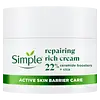What's inside
What's inside
 Key Ingredients
Key Ingredients

 Benefits
Benefits

 Concerns
Concerns

 Ingredients Side-by-side
Ingredients Side-by-side

Water
Skin ConditioningGlycerin
HumectantCaprylic/Capric Triglyceride
MaskingPolyglyceryl-3 Methylglucose Distearate
EmulsifyingPropanediol
SolventStearyl Alcohol
EmollientSodium Acrylate/Sodium Acryloyldimethyl Taurate Copolymer
Emulsion StabilisingStearic Acid
CleansingTapioca Starch
Dicaprylyl Ether
EmollientC15-19 Alkane
SolventCaprylyl Glycol
EmollientHydroxyacetophenone
AntioxidantPolyglyceryl-6 Laurate
EmulsifyingPanthenol
Skin ConditioningCitric Acid
BufferingCentella Asiatica Leaf Extract
Skin ConditioningPolyglycerin-6
HumectantSorbitan Oleate
EmulsifyingCetyl Alcohol
EmollientSorbitan Isostearate
EmulsifyingArachidyl Alcohol
EmollientTocopheryl Acetate
AntioxidantPantolactone
HumectantTocopherol
AntioxidantWater, Glycerin, Caprylic/Capric Triglyceride, Polyglyceryl-3 Methylglucose Distearate, Propanediol, Stearyl Alcohol, Sodium Acrylate/Sodium Acryloyldimethyl Taurate Copolymer, Stearic Acid, Tapioca Starch, Dicaprylyl Ether, C15-19 Alkane, Caprylyl Glycol, Hydroxyacetophenone, Polyglyceryl-6 Laurate, Panthenol, Citric Acid, Centella Asiatica Leaf Extract, Polyglycerin-6, Sorbitan Oleate, Cetyl Alcohol, Sorbitan Isostearate, Arachidyl Alcohol, Tocopheryl Acetate, Pantolactone, Tocopherol
Zinc Oxide
Cosmetic ColorantBenzyl Alcohol 0.39%
PerfumingBenzyl Benzoate 1.01%
AntimicrobialBenzyl Cinnamate 0.15%
PerfumingLanolin 4%
EmollientWater
Skin ConditioningParaffinum Liquidum
EmollientSynthetic Wax
AbrasiveBeeswax
Emulsion StabilisingMicrocrystalline Wax
Emulsion StabilisingSodium Benzoate
MaskingLinalyl Acetate
MaskingPropylene Glycol
HumectantCitric Acid
BufferingBHA
AntioxidantSorbitan Sesquioleate
EmulsifyingParfum
Masking
 Reviews
Reviews

Ingredients Explained
These ingredients are found in both products.
Ingredients higher up in an ingredient list are typically present in a larger amount.
Citric Acid is an alpha hydroxy acid (AHA) naturally found in citrus fruits like oranges, lemons, and limes.
Like other AHAs, citric acid can exfoliate skin by breaking down the bonds that hold dead skin cells together. This helps reveal smoother and brighter skin underneath.
However, this exfoliating effect only happens at high concentrations (20%) which can be hard to find in cosmetic products.
Due to this, citric acid is usually included in small amounts as a pH adjuster. This helps keep products slightly more acidic and compatible with skin's natural pH.
In skincare formulas, citric acid can:
While it can provide some skin benefits, research shows lactic acid and glycolic acid are generally more effective and less irritating exfoliants.
Most citric acid used in skincare today is made by fermenting sugars (usually from molasses). This synthetic version is identical to the natural citrus form but easier to stabilize and use in formulations.
Read more about some other popular AHA's here:
Learn more about Citric AcidWater. It's the most common cosmetic ingredient of all. You'll usually see it at the top of ingredient lists, meaning that it makes up the largest part of the product.
So why is it so popular? Water most often acts as a solvent - this means that it helps dissolve other ingredients into the formulation.
You'll also recognize water as that liquid we all need to stay alive. If you see this, drink a glass of water. Stay hydrated!
Learn more about Water